Everyone knows the third rail is something to avoid:
Getting between motorists and their cars has become the new third rail of California politics
— headline, The Los Angeles Times, 10 Oct. 2017To get the funds, governors would be forced to take on the political third rail of drafting, passing and enacting health insurance legislation that would change coverage for millions of people.
— Anna Maria Barry-Jester, FiveThirtyEight, 20 Sept. 2017[New York Governor Andrew Cuomo] has also promised to find new revenue sources [for the Metropolitan Transportation Authority], even embracing what he had long regarded as a political third rail: congestion pricing.
— Dana Rubinstein and Jimmy Vielkind, Politico, 12 Sept. 2017

Do not touch.
As these examples demonstrate, the term third rail refers to a controversial issue that is usually avoided by politicians.
While politicians steer clear of a third rail out of fear that it'll damage their chances of reelection, there's an even better reason to steer clear of the original third rail: danger of electrocution.
In many subway systems, the pair of rails that the train cars run on are accompanied by a third rail that runs between or alongside them. It's this third rail that provides the electricity that powers the train. If you touch the third rail, that electricity tries to power you instead, which never goes well. This use of third rail dates to the dawn of the first subway systems, in the 1860s.
The literal third rail makes for a powerful metaphor, and the term has been applied over the years to more than just controversial issues avoided by politicians. It's referred to strong whiskey (which packs a jolt) and to incorruptible officials (they can't be touched) and to restaurant tabs (shocking for whoever winds up paying). But none of these have had the staying power of the avoided issue, which remains the only fully established metaphorical use of the term.
That's as far as we can comment on said subject at this time.




